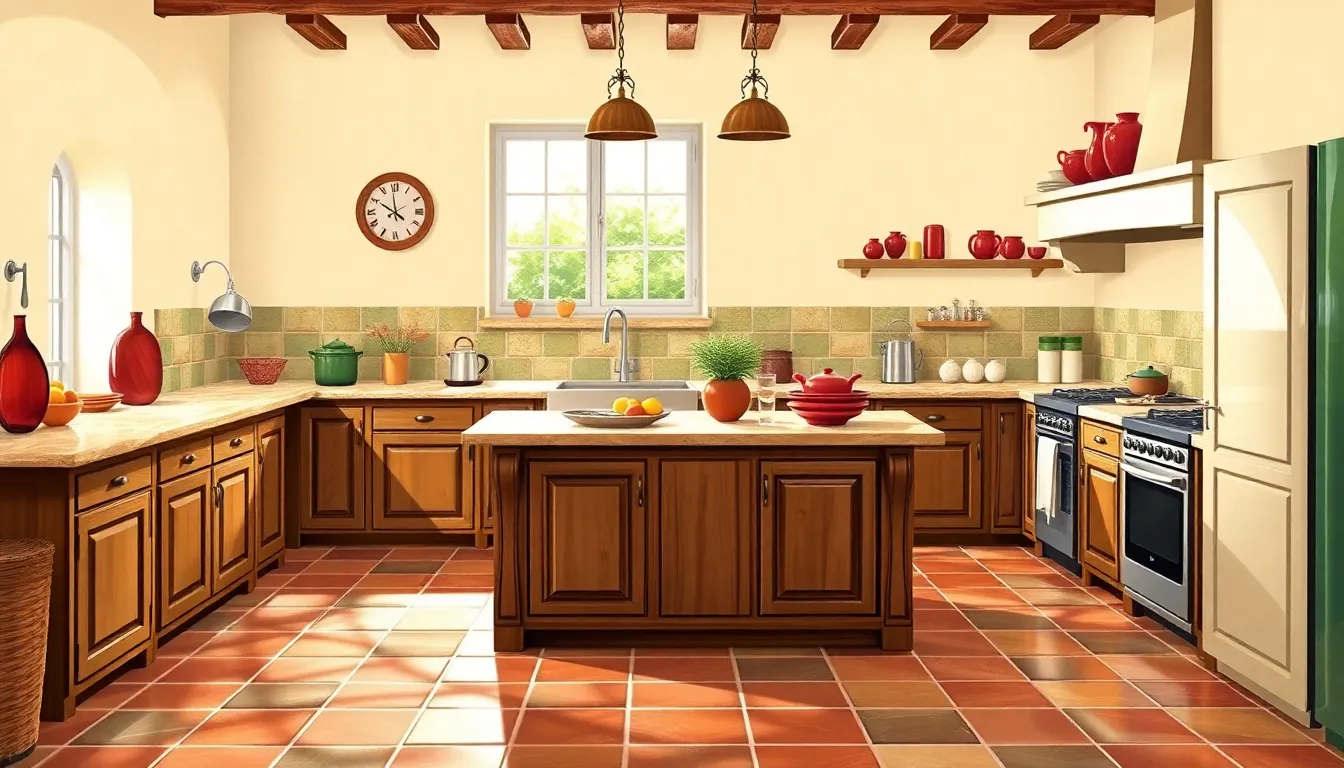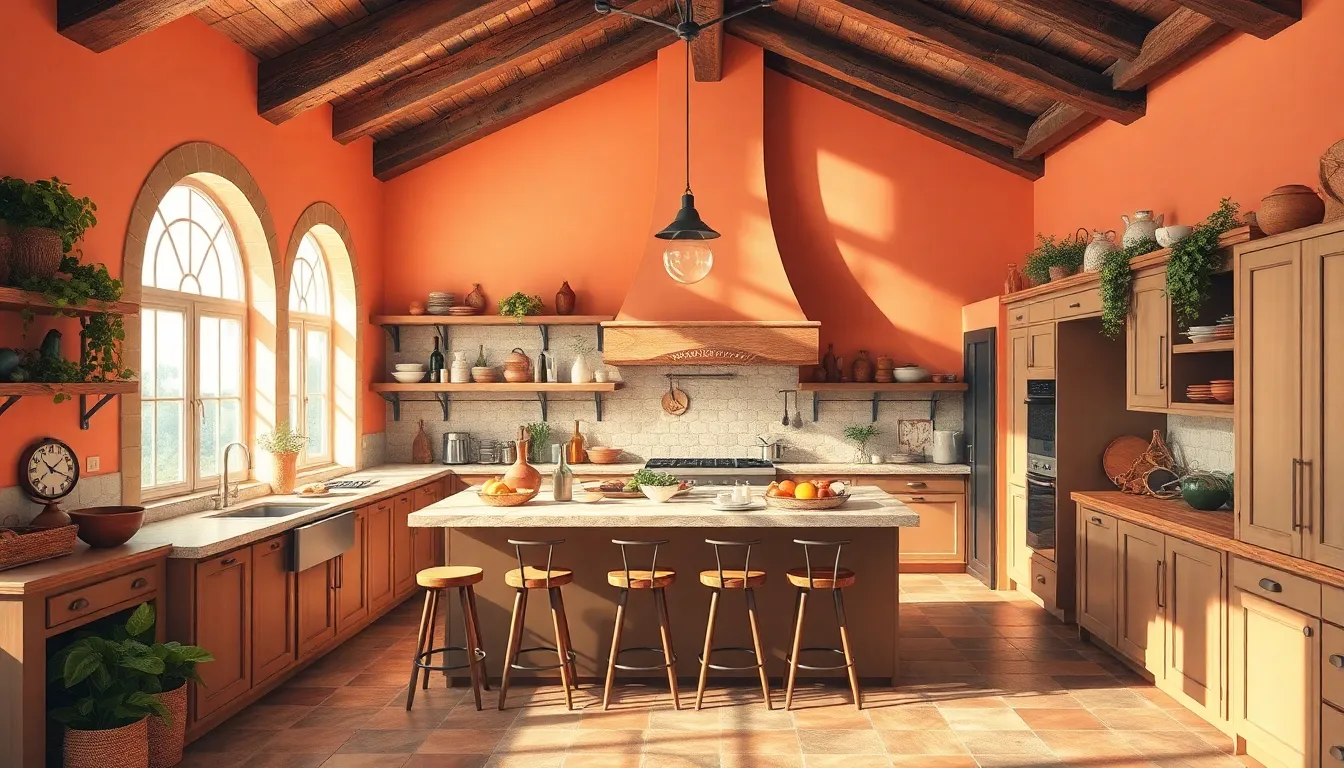Imagine stepping into a kitchen that feels like a cozy Italian trattoria, where the aroma of fresh basil and garlic wafts through the air. Italian kitchen design isn’t just about aesthetics; it’s a celebration of culinary culture and family gatherings. With its warm colors, rustic materials, and inviting layouts, this style transforms cooking into an art form.
From sleek modern interpretations to charming rustic vibes, Italian kitchens blend functionality with flair. Picture yourself whipping up pasta while surrounded by beautiful cabinetry and stunning tile work. It’s not just a kitchen; it’s a space that brings people together. So if you’re ready to spice up your home with a touch of la dolce vita, dive into the world of Italian kitchen design and discover how to create a space that’s as delightful as your favorite pizza.
Table of Contents
ToggleOverview of Italian Kitchen Design
Italian kitchen design emphasizes warmth and functionality, inviting families to gather and share meals. It often showcases a blend of modern and rustic elements, creating a unique atmosphere that encourages culinary creativity. Rich colors such as terracotta, olive green, and cream are commonly used to establish a warm, inviting ambiance.
Natural materials play a significant role in Italian kitchens. Wood, stone, and clay add authenticity, while spacious layouts facilitate movement and social interaction. Open shelving displays beautiful dishware, exemplifying both style and practicality in everyday life.
Homeowners often incorporate essential appliances that maintain efficiency without compromising design aesthetics. Integrating high-quality fixtures and fittings enhances both beauty and functionality, ensuring each element serves a purpose. Large islands or peninsulas frequently act as central gathering spots, bringing people together while providing additional prep space.
Lighting designs contribute to the kitchen’s overall mood, with various options such as pendant lights and under-cabinet lighting creating a warm glow. Combining these elements fosters an inviting atmosphere akin to that of a traditional Italian trattoria.
Unique features might include arched doorways, tile backsplashes, and wrought-iron accents, all contributing to the overall character. Italian kitchen design remains a celebration of culinary tradition and familial connection, making it a timeless choice for any home.
Key Elements of Italian Kitchen Design

Italian kitchen design embodies warmth, functionality, and a sense of heritage. It combines various elements to create an inviting space that’s perfect for cooking and gathering.
Layout and Space Optimization
Space optimization maximizes functionality and promotes interaction. Open-concept designs encourage flow between the kitchen and adjacent living areas. Central islands serve as multifunctional workspaces, providing additional seating for family and friends. U-shaped or L-shaped configurations enhance efficiency by minimizing movement during meal preparation. Ample storage solutions, like tall cabinets or pantries, maintain clutter-free environments while ensuring easy access to essential items. Italian kitchens prioritize organization to enhance both practicality and aesthetic appeal.
Material Selection
Material selection plays a crucial role in defining the character of Italian kitchens. Natural materials like wood, stone, and clay create authentic, rustic atmospheres. Solid wood cabinetry offers durability and warmth, while stone countertops add elegance and resilience. Terracotta tiles not only provide beautiful flooring but also evoke traditional Italian craftsmanship. Additionally, incorporating wrought iron elements adds a touch of charm. The choice of materials emphasizes quality, ensuring functional beauty that stands the test of time.
Color Palette
Color palettes significantly influence the ambiance of Italian kitchens. Rich tones such as terracotta, olive green, and cream contribute to a warm and welcoming environment. Dark wood finishes complement lighter walls, creating visual balance. Accent colors, like deep reds or bright yellows, can be added through decor or dishware, enhancing the kitchen’s character. Natural light enhances these colors, bringing the space to life throughout the day. A thoughtfully chosen palette fosters the cozy feel reminiscent of rustic Italian eateries.
Popular Styles in Italian Kitchen Design
Italian kitchen design encompasses diverse styles, each showcasing distinct characteristics. Two prominent styles include modern and traditional Italian kitchens.
Modern Italian Kitchens
Modern Italian kitchens emphasize sleek lines and minimalist aesthetics. Natural light enhances open layouts, promoting an airy feel. High-quality materials like stainless steel and glass frequently feature in these designs. Bold colors and geometric shapes create striking contrasts, adding visual interest. Functional islands often provide additional workspace and dining areas. Smart technology integrates seamlessly, offering efficiency without sacrificing style. This approach celebrates contemporary living while maintaining Italian culinary traditions.
Traditional Italian Kitchens
Traditional Italian kitchens reflect a timeless charm that evokes nostalgia. Warm tones and rustic materials, such as wooden beams and terracotta tiles, create an inviting atmosphere. Furnishings often include handcrafted details, emphasizing artisanship. Large farmhouse tables serve as central gathering points, promoting family interaction. Color palettes typically feature earthy shades, enhancing the cozy feel of the space. Decorative elements like ceramic dishes and wrought iron accents contribute to a warm, homey ambiance. These kitchens embody the spirit of Italian heritage while serving practical purposes in everyday life.
Influences on Italian Kitchen Design
Italian kitchen design draws heavily from the diverse influences stemming from various regions of Italy, resulting in distinct styles. Each region showcases its own materials and colors. For example, kitchens in Tuscany often highlight terracotta tiles and rich wooden beams, while coastal areas like Liguria feature lighter palettes that reflect the sea. Northern Italian designs may incorporate sleek lines with a focus on function, utilizing modern materials alongside traditional elements.
Cultural influences play a significant role in shaping Italian kitchens. The deep culinary traditions of Italy contribute to their layout and functionality. Family gatherings revolve around cooking, so kitchens prioritize open spaces for interaction. Regional dishes inspire the selections of equipment and storage solutions, while the love for local craftsmanship shines through in bespoke cabinetry and handmade tiles. Historical influences from ancient Rome to the Renaissance also infuse the aesthetics, creating kitchens that honor Italy’s rich heritage while serving practical needs.
Tips for Incorporating Italian Kitchen Design
Incorporating Italian kitchen design entails thoughtful selection of fixtures, appliances, and storage solutions.
Choosing the Right Fixtures and Appliances
Opt for high-quality fixtures that reflect Italian craftsmanship. Materials like brushed nickel or brass can add a classic touch. Select modern appliances that blend seamlessly with traditional aesthetics. Brands known for their Italian heritage offer stylish options, ensuring both functionality and elegance. Gas ranges often feature in Italian kitchens, enhancing the cooking experience. Choosing open shelving allows for display of beautiful dishware, showcasing a personal connection to culinary traditions. Prioritize finishes that resonate with warm colors found in Italian decor, like muted bronze or rich copper.
Customizing Storage Solutions
Utilize custom cabinetry to maximize storage while maintaining style. Deep drawers allow for easy access to cookware, promoting convenience in meal prep. Implementing pull-out shelves facilitates the organization of pantry items, enhancing efficiency. Open shelving can create a sense of space while displaying personal items. Incorporate built-in wine racks to celebrate Italy’s wine culture. Unique storage solutions, such as corner cabinets, can optimize awkward spaces. The focus remains on creating a clutter-free environment that complements the warm ambiance of Italian kitchens.
Italian kitchen design embodies warmth and functionality while celebrating rich culinary traditions. By blending rustic charm with modern efficiency, it creates inviting spaces that encourage family gatherings and culinary creativity. The thoughtful use of materials and colors fosters a cozy atmosphere that resonates with the essence of Italian culture.
Whether opting for a traditional farmhouse aesthetic or a sleek modern look, incorporating key elements like open layouts and quality craftsmanship can transform any kitchen into a vibrant heart of the home. Embracing this design style not only enhances the cooking experience but also honors the heritage that makes Italian kitchens truly special.



